 Things are heating up in the entry-level/enthusiast end of the photography market, with Pentax announcing two new new dSLR cameras offering 6.1 effective megapixels.
Things are heating up in the entry-level/enthusiast end of the photography market, with Pentax announcing two new new dSLR cameras offering 6.1 effective megapixels.
The Pentax K100 and K110D cameras both offer high precision 11-point wide frame AF, ISO sensitivity from 200 to 3200 ISO, a large 2.5-inch LCD screen and a shutter speed extending from 30 secs to a superfast 1/4000 sec
The cameras are compatible with most of the huge selection of existing Pentax lenses, including PENTAX K-, KA-, KAF- and KAF2-mount lenses; screw-mount lenses (with an adapter); and 645- are 67-system lenses (with an adapter) – although there may be limited functionality with some older lenses.
K100D : non shake, non rattle and non roll
Entering a market already dominated by excellent low-price models by Nikon and Canon, Pentax are hoping that the anti-shake widget in the K100D – which effectively offers a two-stop advantage – will get punters waving their wads in their direction
 It’s Pentax’s first DSLR to feature a CCD-shift Shake Reduction system – and works by oscillating the CCD image sensor vertically and horizontally at high speed using magnetic force, while adjusting the speed of oscillation in proportion to the amount of camera shake detected by a built-in sensor (err, got that?).
It’s Pentax’s first DSLR to feature a CCD-shift Shake Reduction system – and works by oscillating the CCD image sensor vertically and horizontally at high speed using magnetic force, while adjusting the speed of oscillation in proportion to the amount of camera shake detected by a built-in sensor (err, got that?).
K110D – cheap’n’cheerful
The entry-level digital K110D is exactly the same as the K100D but comes without the Shake Reduction.
Both cameras come with Pentax’s smarty-pants Auto Picture Mode for point’n’shooters. This automatically selects one of the five Picture modes – including Portrait, Landscape and Macro – by calculating various photographic factors to assure top notch results.
There’s also the usual selection of scene modes including Night Scene, Surf & Snow, Text, Sunset, Kids and Museum
 The Pentax K100D (with smc 18-55mm lens) will be shunting off the shelves for around $700, while the K110D will ship with the same lens for a competitive $600.
The Pentax K100D (with smc 18-55mm lens) will be shunting off the shelves for around $700, while the K110D will ship with the same lens for a competitive $600.
Pentax K100D/ K110D specifications
Sensor 6.1 million effective pixels
Image sizes 3008 x 2000, 3008 x 2008 (RAW), 2400 x 1600, 1536 x 1024,
File formats JPEG (8-bit), RAW (12-bit), DCF, DPOF, PRINT Image Matching lll
Lens Mount Pentax KAF bayonet mount
Focus TTL Phase-matching 11-point wide autofocus system (SAFOX Vlll), AF Single, Manual, AF Continuous
Image Stabilization Shake Reduction (SR) system (K100 only)
AF assist lamp Yes (by built-in flash)
Metering TTL open-aperture 16-segment (coupled with lens and AF information), Multi-segment, Center-weighted, Spot
ISO sensitivity Auto, ISO 200, ISO 400, ISO 800, ISO 1600, ISO 3200
Exposure compensation +/- 2EV, 1/2EV or 1/3 EV steps
Exposure bracketing 3 frames within range of +/-0.5EV, +/-1.0EV, +/-1.5EV (0.5EV steps) or +/-0.3EV, +/-0.7EV, +/-1.0EV (0.3EV steps)
Shutter Electronically controlled vertical-run focal plane shutter
Shuttter speed 1/4000 – 30 sec
Modes Auto Picture mode, Picture mode, Scene, Program AE, Shutter Priority AE, Aperture Priority AE, Metered Manual, Bulb
Picture modes Portrait, Landscape, Macro, Action, Night Scene Portrait, Standard Flash Off
White balance Auto, Daylight, Shade, Cloudy, Tungsten Light, Fluorescent Light (W, D, N), Flash, Manual
Continuous shooting Approx 2.8 fps: JPEG(up to 5fps), RAW(up to 3fps)
Flash Built-in retractable P-TTL pop-up, Guide number 15.6
Viewfinder Fixed molded penta-mirror type, 96% field of view
LCD monitor 2.5-inch low temperature polysilicon TFT, 210,000 pixels
Connectivity USB 2.0 Hi-speed
Storage SD card
Power 4 x AA batteries(Alkaline, Lithium, rechargeable Ni-MH), 2 x CR-V3 llithium batteries, Optional AC adapter
Weight (no batt) 560 g (19.8 oz) 485 g
Dimensions 129.5 x 92.5 x 70 mm (5.1 x 3.6 x 2.8 in)
Pentax
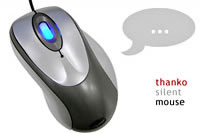 Is your late night keyboard clattering keeping your partner awake? Is your incessant mouse-clicking sending your friends mad? Or have you just got a bit of a problem with clattering, clicking things?
Is your late night keyboard clattering keeping your partner awake? Is your incessant mouse-clicking sending your friends mad? Or have you just got a bit of a problem with clattering, clicking things? The illustration on their site seems to suggest that they’ve achieved this hush factor by simply slamming in a slab of silicone stuff into the mouse, but we’re sure there must be a bit more hi-tech jiggerypokery involved than that (surely?!!).
The illustration on their site seems to suggest that they’ve achieved this hush factor by simply slamming in a slab of silicone stuff into the mouse, but we’re sure there must be a bit more hi-tech jiggerypokery involved than that (surely?!!). The keyboard that’s as quiet as a, err, mouse
The keyboard that’s as quiet as a, err, mouse It’s a pretty basic looking affair with none of the groovy extras that Logitech like to bolt on, so gadget freaks are unlikely to be impressed.
It’s a pretty basic looking affair with none of the groovy extras that Logitech like to bolt on, so gadget freaks are unlikely to be impressed.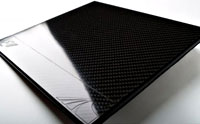 Designed exclusively for idiots with more money than sense, the official Formula 1 carbon and leather mouse mat can now be bought online for just £260 ($489, €380)
Designed exclusively for idiots with more money than sense, the official Formula 1 carbon and leather mouse mat can now be bought online for just £260 ($489, €380)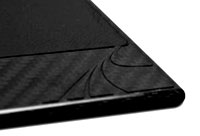 The blurb on the Formula 1 webpage insists that the carbon mouse mat was designed “using state of the art automotive 3D modelling software.”
The blurb on the Formula 1 webpage insists that the carbon mouse mat was designed “using state of the art automotive 3D modelling software.”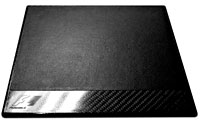 (There is a rather better looking all-carbon version available for ‘just’ £250, but this won’t work with an optical mouse).
(There is a rather better looking all-carbon version available for ‘just’ £250, but this won’t work with an optical mouse). Look, we know there’s something a bit sad about wanting a PC that glows brightly with useless dials, flashing lights and obscure read outs, but we just couldn’t hide our juvenile excitement when we saw this new gizmo from Japanese manufacturer Scythe.
Look, we know there’s something a bit sad about wanting a PC that glows brightly with useless dials, flashing lights and obscure read outs, but we just couldn’t hide our juvenile excitement when we saw this new gizmo from Japanese manufacturer Scythe.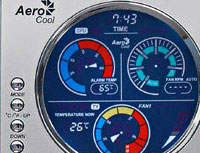 The panel is dominated by a large, circular colour LCD display giving readouts for computer temperature (centigrade/Fahrenheit, with up to four temperature sensors supported), fan speed, warning temperature and current time.
The panel is dominated by a large, circular colour LCD display giving readouts for computer temperature (centigrade/Fahrenheit, with up to four temperature sensors supported), fan speed, warning temperature and current time.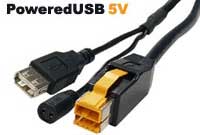 Pricing and availability to be announced. We’ll take two please!
Pricing and availability to be announced. We’ll take two please!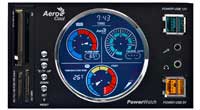 PoweredUSB
PoweredUSB “Would you like a single piece of sheet music that contains all your favourite pieces, and never needs to be turned over?”
“Would you like a single piece of sheet music that contains all your favourite pieces, and never needs to be turned over?” The universal piece of music wasn’t even the first prize winner in this competition. It was a contest sponsored by one of the world’s leading e-paper technology designers, Plastic Logic, which has demonstrated a flexible sheet of A5 “paper” that has the contrast and readability of real paper, the flexibility of soft cardboard, and the power consumption of a watch. And the prize went to something that is, in the end, “just a book.”
The universal piece of music wasn’t even the first prize winner in this competition. It was a contest sponsored by one of the world’s leading e-paper technology designers, Plastic Logic, which has demonstrated a flexible sheet of A5 “paper” that has the contrast and readability of real paper, the flexibility of soft cardboard, and the power consumption of a watch. And the prize went to something that is, in the end, “just a book.”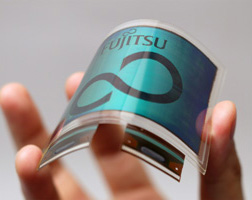 When you invent a new technology, you always start off by producing something which you know has a market already, and which you think you can do better.
When you invent a new technology, you always start off by producing something which you know has a market already, and which you think you can do better.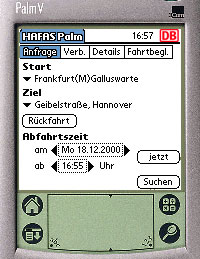 If you’re a regular train traveller across the UK, or you’re planning a holiday involving lots of different journeys, keeping track of all the various train times can be a bit of a pain.
If you’re a regular train traveller across the UK, or you’re planning a holiday involving lots of different journeys, keeping track of all the various train times can be a bit of a pain. Then it’s a case of bashing the ‘create’ buttom and waiting for a few minutes as the Teutonic technlogoy does it thing, before being presented with links to your timetable (you can elect to download the timetable directly from the site or have the files emailed to you).
Then it’s a case of bashing the ‘create’ buttom and waiting for a few minutes as the Teutonic technlogoy does it thing, before being presented with links to your timetable (you can elect to download the timetable directly from the site or have the files emailed to you). This small download provides a simple interface serving up enough timetable-related data to give train buffs a moist spot or two.
This small download provides a simple interface serving up enough timetable-related data to give train buffs a moist spot or two. Details are still a bit sketchy on these shiny new fellas, but Sharp’s new range of flash based MP3 players sure look mighty purdy to our jaded eyes.
Details are still a bit sketchy on these shiny new fellas, but Sharp’s new range of flash based MP3 players sure look mighty purdy to our jaded eyes.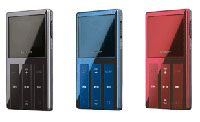 As is de rigueur these days with (non Apple) MP3 players, there’s an FM tuner onboard with direct audio encoding – great for recording radio shows or capturing your mobile mumblings via the built in microphone
As is de rigueur these days with (non Apple) MP3 players, there’s an FM tuner onboard with direct audio encoding – great for recording radio shows or capturing your mobile mumblings via the built in microphone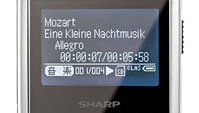 The measurements of the MP-B200 and MP-B300 are 49 x 87.6 x 8.9mm – pretty damn small, but positively bun-scoffing compared to 6.8mm thickness of the Apple iPod.
The measurements of the MP-B200 and MP-B300 are 49 x 87.6 x 8.9mm – pretty damn small, but positively bun-scoffing compared to 6.8mm thickness of the Apple iPod.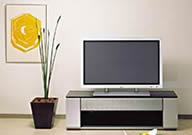 The geek bit
The geek bit 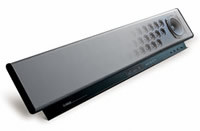 Tech specs
Tech specs 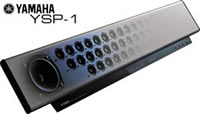 Yamaha’s YSP-1 is a marvel of technology, it’s about 42 inches long by 4 inches high and about 4 inches deep but can produce 5.1 audio that really does sounds like a conventional set-up with speakers in-front and behind you.
Yamaha’s YSP-1 is a marvel of technology, it’s about 42 inches long by 4 inches high and about 4 inches deep but can produce 5.1 audio that really does sounds like a conventional set-up with speakers in-front and behind you. A box is a box without careful set-up
A box is a box without careful set-up If you’ve got a big stack of top notch vinyl gathering dust at home, you may want to consider using this natty USB Turntable to record the platters that matter straight on to your desktop or laptop PC.
If you’ve got a big stack of top notch vinyl gathering dust at home, you may want to consider using this natty USB Turntable to record the platters that matter straight on to your desktop or laptop PC.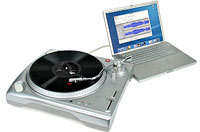 The turntable can also be hooked up to any home stereo with CD or auxiliary inputs so you can rock out to your old punk rock 45s after a night in the pub.
The turntable can also be hooked up to any home stereo with CD or auxiliary inputs so you can rock out to your old punk rock 45s after a night in the pub.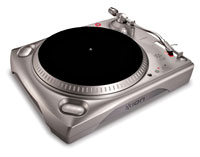 Using your existing turntable
Using your existing turntable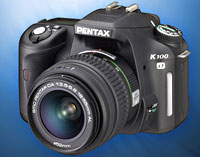 Things are heating up in the entry-level/enthusiast end of the photography market, with Pentax announcing two new new dSLR cameras offering 6.1 effective megapixels.
Things are heating up in the entry-level/enthusiast end of the photography market, with Pentax announcing two new new dSLR cameras offering 6.1 effective megapixels.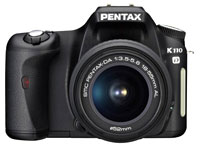 It’s Pentax’s first DSLR to feature a CCD-shift Shake Reduction system – and works by oscillating the CCD image sensor vertically and horizontally at high speed using magnetic force, while adjusting the speed of oscillation in proportion to the amount of camera shake detected by a built-in sensor (err, got that?).
It’s Pentax’s first DSLR to feature a CCD-shift Shake Reduction system – and works by oscillating the CCD image sensor vertically and horizontally at high speed using magnetic force, while adjusting the speed of oscillation in proportion to the amount of camera shake detected by a built-in sensor (err, got that?).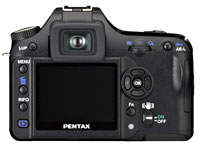 The Pentax K100D (with smc 18-55mm lens) will be shunting off the shelves for around $700, while the K110D will ship with the same lens for a competitive $600.
The Pentax K100D (with smc 18-55mm lens) will be shunting off the shelves for around $700, while the K110D will ship with the same lens for a competitive $600.